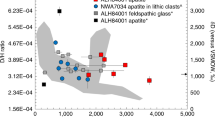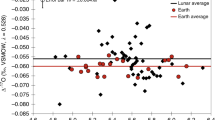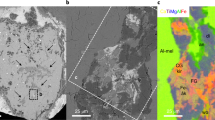Abstract
Water plays a critical role in the evolution of planetary bodies1, and determination of the amount and sources of lunar water has profound implications for our understanding of the history of the Earth–Moon system. During the Apollo programme, the lunar samples were found to be devoid of indigenous water2,3. The severe depletion of volatiles, including water, in lunar rock samples4 has long been seen as strong support for the theory that the Moon formed during a giant impact event5. Water has now been identified in lunar volcanic glasses6 and apatite7,8,9, but the sources of water to the Moon have not been determined. Here we report ion microprobe measurements of water and hydrogen isotopes in the hydrous mineral apatite, derived from crystalline lunar mare basalts and highlands rocks collected during the Apollo missions. We find significant water in apatite from both mare and highlands rocks, indicating a role for water during all phases of the Moon’s magmatic history. Variations of hydrogen isotope ratios in apatite suggest sources for water in lunar rocks could come from the lunar mantle, solar wind protons and comets. We conclude that a significant delivery of cometary water to the Earth–Moon system occurred shortly after the Moon-forming impact.
This is a preview of subscription content, access via your institution
Access options
Subscribe to this journal
Receive 12 print issues and online access
$259.00 per year
only $21.58 per issue
Buy this article
- Purchase on Springer Link
- Instant access to full article PDF
Prices may be subject to local taxes which are calculated during checkout



Similar content being viewed by others
References
Albaréde, F. Volatile accretion history of the terrestrial planets and dynamic implications. Nature 461, 1227–1233 (2009).
Epstein, S. & Taylor, H. P. Jr Proc. 4th Lunar Sci. Conf., Vol. 2, 1559–1575 (Pergamon, 1973).
Epstein, S. & Taylor, H. P. Jr Proc. 5th Lunar Sci. Conf., Vol. 2, 1839–1854 (Pergamon, 1974).
Taylor, S. R., Taylor, G. J. & Taylor, L. A. The Moon: A Taylor perspective. Geochim. Cosmochim. Acta 70, 5904–5918 (2006).
Canup, R. M. & Asphaug, E. Origin of the Moon in a giant impact near the end of the Earth’s formation. Nature 412, 708–712 (2001).
Saal, A. E. et al. Volatile content of lunar volcanic glasses and the presence of water in the Moon’s interior. Nature 454, 192–195 (2008).
McCubbin, F. M. et al. Nominally hydrous magmatism on the Moon. Proc. Natl Acad. Sci. 27, 11223–11228 (2010).
McCubbin, F. M. et al. Detection of structurally bound hydroxyl in fluorapatite from Apollo mare basalt 15058,128 using TOF-SIMS. Am. Mineral. 95, 1141–1150 (2010).
Boyce, J. W. et al. Lunar apatite with terrestrial volatile abundances. Nature 466, 466–469 (2010).
Friedman, I., O’Neil, J. R., Adami, L. H., Gleason, J. D. & Hardcastle, K. Water, hydrogen, deuterium, carbon, carbon-13, and oxygen-18 content of selected lunar material. Science 167, 538–540 (1970).
Taylor, L. A., Mao, H. K. & Bell, P. M. Proc. 4th Lunar Sci. Conf., Vol. 1, 829–839 (Pergamon, 1973).
Sheppard, S. M. F. in Stable Isotopes in High Temperature Geological Processes (eds Valley, J. W., Taylor, H. P. Jr & O’Neil, J. R.) 165–183 (Reviews in Mineralogy 16, Mineralogical Society of America, 1986).
Craig, H. Isotopic variations in meteoric waters. Science 133, 1702–1703 (1961).
Robert, F. in Meteorites and the Early Solar System II (eds Lauretta, D. & McSween, H. Y. Jr) 341–352 (Univ. Arizona Press, 2006).
Watson, L. L., Hutcheon, I. D., Epstein, S. & Stolper, E. M. Water on Mars: Clues from deuterium/hydrogen and water contents of hydrous phases in SNC meteorites. Science 265, 86–90 (1994).
Greenwood, J. P., Itoh, S., Sakamoto, N., Vicenzi, E. P. & Yurimoto, H. Hydrogen isotope evidence for loss of water from Mars through time. Geophys. Res. Lett. 35, L05203 (2008).
Papike, J. J., Ryder, G. & Shearer, C. K. in Planetary Materials (ed. Papike, J. J.) 5-01-5-234 (Reviews in Mineralogy 36, Mineralogical Society of America,1998).
Deloule, E., Albaréde, F. & Sheppard, S. M. F. Hydrogen isotope heterogeneities in the mantle from ion probe analysis of amphiboles from ultramafic rocks. Earth Planet. Sci. Lett. 105, 543–555 (1991).
Harford, C. L. & Sparks, R. S. J. Recent remobilisation of shallow-level intrusions on Montserrat revealed by hydrogen isotope composition of amphiboles. Earth Planet. Sci. Lett. 185, 285–297 (2001).
Rhodes, J. M., Blanchard, D. P., Dungan, M. A., Brannon, J. C. & Rodgers, K. V. Proc. Lunar Sci. Conf. 8th 1305–1338 (Pergamon, 1977).
Sharp, Z. D., Shearer, C. K., McKeegan, K. D., Barnes, J. D. & Wang, Y. Q. The chlorine isotope composition of the Moon and implications for an anhydrous mantle. Science 329, 1050–1053 (2010).
Shearer, C. K. & Papike, J. J. Magmatic evolution of the Moon. Am. Mineral. 84, 1469–1494 (1998).
Pahlevan, K. & Stevenson, D. J. Equilibration in the aftermath of the lunar-forming giant impact. Earth Planet. Sci. Lett. 262, 438–449 (2007).
Taylor, L. A., Patchen, A., Mayne, R. G. & Taylor, D-H. The most reduced rock from the moon, Apollo 14 basalt 14053: Its unique features and their origin. Am. Mineral. 89, 1617–1624 (2004).
Ong, L., Asphaug, E. I., Korycansky, D. & Coker, R. F. Volatile retention from cometary impacts on the Moon. Icarus 207, 578–589 (2010).
Hashizume, K., Chaussidon, M., Marty, B. & Robert, F. Solar wind record on the Moon: Deciphering presolar from planetary nitrogen. Science 290, 1142–1145 (2000).
Kokubu, N., Mayeda, T. & Urey, H. C. Deuterium content of minerals, rocks, and liquid inclusions from rocks. Geochim. Cosmochim. Acta 21, 247–256 (1961).
Acknowledgements
We thank F. M. McCubbin and F. Robert for constructive reviews, M. Gilmore and W. Herbst for comments on an earlier version of this manuscript, M. Rutherford and A. Basilevsky for discussion, G. Olack and J. Eckert for technical assistance, and Wesleyan University (J.P.G.) and Monkasho (H.Y.) for support.
Author information
Authors and Affiliations
Contributions
J.P.G., S.I., N.S. and H.Y. carried out all ion microscopy. J.P.G. conducted all electron microscopy and measurements of water and D/H in apatite standards using continuous-flow mass spectrometry. All authors contributed to writing of the manuscript.
Corresponding author
Ethics declarations
Competing interests
The authors declare no competing financial interests.
Supplementary information
Supplementary Information
Supplementary Information (PDF 997 kb)
Rights and permissions
About this article
Cite this article
Greenwood, J., Itoh, S., Sakamoto, N. et al. Hydrogen isotope ratios in lunar rocks indicate delivery of cometary water to the Moon. Nature Geosci 4, 79–82 (2011). https://doi.org/10.1038/ngeo1050
Received:
Accepted:
Published:
Issue Date:
DOI: https://doi.org/10.1038/ngeo1050
This article is cited by
-
A solar wind-derived water reservoir on the Moon hosted by impact glass beads
Nature Geoscience (2023)
-
Evidence of water on the lunar surface from Chang’E-5 in-situ spectra and returned samples
Nature Communications (2022)
-
Chang’E-5 samples reveal high water content in lunar minerals
Nature Communications (2022)
-
Distribution of water phase near the poles of the Moon from gravity aspects
Scientific Reports (2022)



